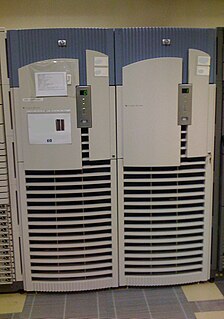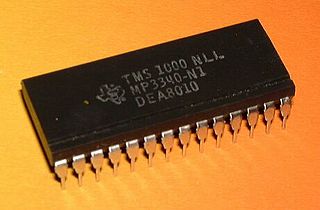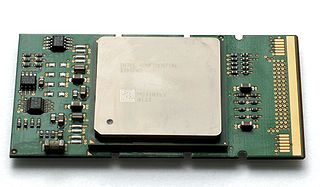
IA-64 is the instruction set architecture (ISA) of the Itanium family of 64-bit Intel microprocessors. The basic ISA specification originated at Hewlett-Packard (HP), and was evolved and then implemented in a new processor microarchitecture by Intel with HP's continued partnership and expertise on the underlying EPIC design concepts. In order to establish what was their first new ISA in 20 years and bring an entirely new product line to market, Intel made a massive investment in product definition, design, software development tools, OS, software industry partnerships, and marketing. To support this effort Intel created the largest design team in their history and a new marketing and industry enabling team completely separate from x86. The first Itanium processor, codenamed Merced, was released in 2001.

Socket 7 is a physical and electrical specification for an x86-style CPU socket on a personal computer motherboard. It was released June 1995. The socket supersedes the earlier Socket 5, and accepts P5 Pentium microprocessors manufactured by Intel, as well as compatibles made by Cyrix/IBM, AMD, IDT and others.

Xeon is a brand of x86 microprocessors designed, manufactured, and marketed by Intel, targeted at the non-consumer workstation, server, and embedded system markets. It was introduced in June 1998. Xeon processors are based on the same architecture as regular desktop-grade CPUs, but have some advanced features such as support for ECC memory, higher core counts, support for larger amounts of RAM, larger cache memory and extra provision for enterprise-grade reliability, availability and serviceability features responsible for handling hardware exceptions through the Machine Check Architecture. They are often capable of safely continuing execution where a normal processor cannot due to these extra RAS features, depending on the type and severity of the Machine Check Exception. Some also support multi-socket systems with two, four, or eight sockets through use of the Quick Path Interconnect bus.
The Itanium 9300 series, code-named Tukwila, is the generation of Intel's Itanium processor family following Itanium 2 and Montecito. It was released on 8 February 2010. It utilizes both multiple processor cores (multi-core) and SMT techniques. The engineers said to be working on this project were from the DEC Alpha project, specifically those who worked on the Alpha 21464 (EV8), which was focused on SMT.

LGA 775, also known as Socket T, is an Intel desktop CPU socket. LGA stands for land grid array. Unlike earlier common CPU sockets, such as its predecessor Socket 478, the LGA 775 has no socket holes; instead, it has 775 protruding pins which touch contact points on the underside of the processor (CPU).

Altix is a line of server computers and supercomputers produced by Silicon Graphics, based on Intel processors. It succeeded the MIPS/IRIX-based Origin 3000 servers.

Socket 604 is a 604-pin microprocessor socket designed to interface an Intel's Xeon processor to the rest of the computer. It provides both an electrical interface as well as physical support. This socket is designed to support a heatsink.

LGA 771, also known as Socket J, is a CPU interface introduced by Intel in 2006. It is used in Intel Core microarchitecture based DP-capable server processors, the Dual-Core Xeon is codenamed Dempsey, Woodcrest, and Wolfdale and the Quad-Core processors Clovertown, Harpertown, and Yorkfield-CL. It is also used for the Core 2 Extreme QX9775.

Socket M (mPGA478MT) is a CPU interface introduced by Intel in 2006 for the Intel Core line of mobile processors.

The HP Superdome is a high-end server computer developed and produced by Hewlett Packard Enterprise. The latest version of product, "Superdome 2" was introduced in 2010. Superdome 2 scales from 2 to 32 sockets and 4 TB of memory. When introduced in 2000, the Superdome used PA-RISC processors. Since 2002, there has been another version of the machine based on Itanium 2 processors, marketed in parallel as the HP Integrity Superdome. The classic PA-RISC Superdome was subsequently rebranded to HP 9000 Superdome. The predecessor to the Superdome was the HP V-Class.

LGA 1366, also known as Socket B, is an Intel CPU socket. This socket supersedes Intel's LGA 775 in the high-end and performance desktop segments. It also replaces the server-oriented LGA 771 in the entry level and is superseded itself by LGA 2011. LGA stands for land grid array. This socket has 1,366 protruding pins which touch contact points on the underside of the processor (CPU) and accesses up to three channels of DDR3 memory via the processor's internal memory controller.

Socket PAC418 is a 418 pin microprocessor socket designed to interface an Intel Itanium processor to the rest of the computer. It provides both an electrical interface as well as physical support. This socket is designed to support a microprocessor module.

LGA 1156, also known as Socket H or H1, is an Intel desktop CPU socket. LGA stands for land grid array. Its incompatible successor is LGA 1155.

LGA 1248 is an Intel CPU Socket for Itanium processors from the 9300-series to the 9700-series. It replaces PAC611 used by Itanium 9100-series processors and adds Intel QuickPath Interconnect functionalities.

LGA 2011, also called Socket R, is a CPU socket by Intel. Released on November 14, 2011, it replaces Intel's LGA 1366 and LGA 1567 in the performance and high-end desktop and server platforms. The socket has 2011 protruding pins that touch contact points on the underside of the processor.
LGA 1356, also called Socket B2, is an Intel microprocessor socket released in Q1 2012 for the two processor (2P) segment of the server market. It supports 3 64-bit wide DDR3 channels, whereas socket LGA 2011 supports 4 channels and socket LGA 1155 supports 2 channels.

















